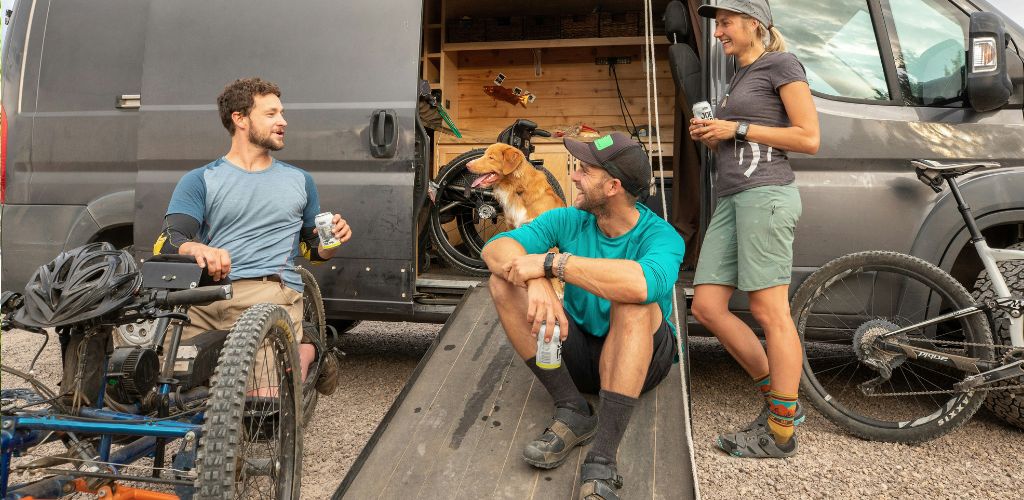Adaptive mountain biking (aMTB) is a transformative and inclusive approach to mountain biking that ensures individuals with physical disabilities can enjoy the sport.
Essentially, it involves using specialized equipment like adaptive mountain bikes, which are designed to accommodate various physical limitations, be it mobility, balance, or strength-related.
These bikes often feature hand-cycles for riders who use wheelchairs, three or four-wheel designs for added stability, and custom control systems for those with limited arm or hand strength.
As someone deeply embedded in the mountain biking community, it’s thrilling to see how aMTB is breaking barriers and opening up the trails to a broader audience – as well as allowing mountain bikers who have tragically suffered traumatic and debilitating back and neck injuries to regain their freedom on the trail, that they loved so much before injury took that from them.
It’s not just about the ride; it’s about the shared experience, the joy of being in nature, and the personal challenges overcome.
Choosing the Right Adaptive Mountain Bike
Selecting the right adaptive mountain bike is crucial for a safe and enjoyable experience.
The variety can be overwhelming, but it primarily boils down to the rider’s specific needs.
For instance, a handcycle is ideal for riders with limited leg mobility but good upper body strength. These bikes have hand cranks and are available in different models like upright, recumbent, or kneeling positions.
For those who need more stability than a standard two-wheeled bike can offer, trikes or quads (three or four wheels, respectively) are great options. They offer a lower center of gravity and can include electric assist motors to help with challenging terrain.
Some bikes also come with custom seating solutions, like supportive backrests or side supports, ensuring comfort and safety throughout the ride.
Customization is key in adaptive mountain biking. Everything from the braking system to gear shifts can be tailored to the rider’s physical capabilities.
This might mean installing electronic shifters for someone with limited hand dexterity or a braking system that can be activated with minimal force.
Trail Accessibility and Selection
Trail selection is a crucial aspect of adaptive mountain biking. Not all trails are suitable for adaptive bikes, which are often wider and require a different kind of navigation.
It’s important to research and find trails that are aMTB-friendly.
Many mountain biking locations are now recognizing the need for inclusivity and are adapting their trails to be more accessible.
When selecting trails, consider factors like trail width, surface type, gradient, and technical features. Wide and well-maintained trails with minimal obstacles are usually a good starting point.
Progressive difficulty is key – start with easier trails and gradually move to more challenging ones as confidence and skills grow.
Local mountain biking clubs and organizations can be great resources for finding accessible trails. They often have updated information on trail conditions and can offer advice on which trails are best suited for adaptive bikes.
Additionally, connecting with other adaptive riders can provide valuable insights and recommendations based on firsthand experience.
Training and Safety
Safety and proper training are paramount in adaptive mountain biking, just as they are in traditional mountain biking.
Before hitting the trails, it’s essential to get comfortable with the adaptive bike in a controlled environment. This might involve learning how to balance, steer, brake, and shift gears effectively.
For new riders, or those new to adaptive biking, consider working with a coach or instructor who has experience in aMTB. They can provide tailored guidance and help develop the skills needed to navigate different types of terrain safely.
Wearing appropriate safety gear is non-negotiable. This includes a helmet, gloves, and protective eyewear at a minimum.
Depending on the nature of the disability, additional protective gear like chest protectors or padded clothing might be advisable.
Always inform someone about your riding plans and, if possible, ride with a buddy. In case of an emergency, it’s vital to have a plan in place, especially in more remote areas.
This might include carrying a mobile phone, a basic first aid kit, and knowing the location of the nearest medical facility.
The Community and Advancing aMTB
The growth of adaptive mountain biking is heavily reliant on community support and advocacy. Involvement in the aMTB community can range from participating in group rides and events to advocating for more accessible trails and facilities.
Social media and online forums have become hubs for connecting adaptive riders. These platforms offer a space to share experiences, tips, and encouragement. Moreover, they can be instrumental in organizing group rides or events, which are fantastic opportunities for learning and enjoyment.
Advocacy plays a critical role in the development of aMTB. This can involve working with local trail associations, parks, and recreation departments to ensure trails are accessible and meeting the needs of adaptive riders.
Participation in trail building and maintenance days also shows commitment to the broader mountain biking community and helps foster inclusivity.
Remember, adaptive mountain biking isn’t just about the equipment or the trails; it’s about the community, the shared experiences, and the joy of being able to participate in a sport that we love, regardless of physical limitations.
It’s about pushing boundaries, both personal and societal, and continually working towards a more inclusive and accessible mountain biking environment for all.
See you on the trail!

